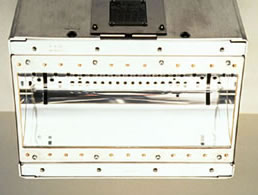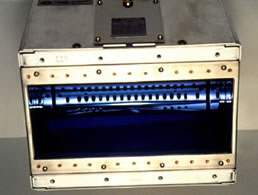Guide to UV Measurement
Dichroic Reflectors
There have been elaborate and costly methods applied to reducing IR from UV lamps, but by far the simplest and most direct is the use of a dichroic reflector. Dichroic reflectors are designed to be non-reflective to IR emitted from the lamp. Whether the transmission-type or absorbing-type, they reduce the focused IR, and consequently the temperature to which the surface rises.
The total UV reflectivity can be very good for a well-designed dichroic reflector (see below). A comparison of the cure speed and surface temperature rise for a cure system with and without a dichroic reflector is shown here.
Cure Speed and Temperature Rise |
||
Lamp 120 w/cm, "D" bulb |
Cure Speed m/min |
Temperature Rise |
Standard Reflector |
21.1 |
29 |
Dichroic Reflector |
19.7 |
18 |
Black screen ink on 10 mil polycarbonate, 390 mesh |
||
In this example, a significant reduction in peak temperature is accompanied by only a slight reduction in cure speed.
Dichroic reflectors can be distinguished from standard, broadband UV reflectors by their appearance. While broadband reflectors will appear clear and shiny to the eye, dichroic reflectors will appear blue or purple. This is because the dichroic is not reflecting most of the visible spectrum.
 |
 |
Broadband Reflector |
Dichroic Reflector |